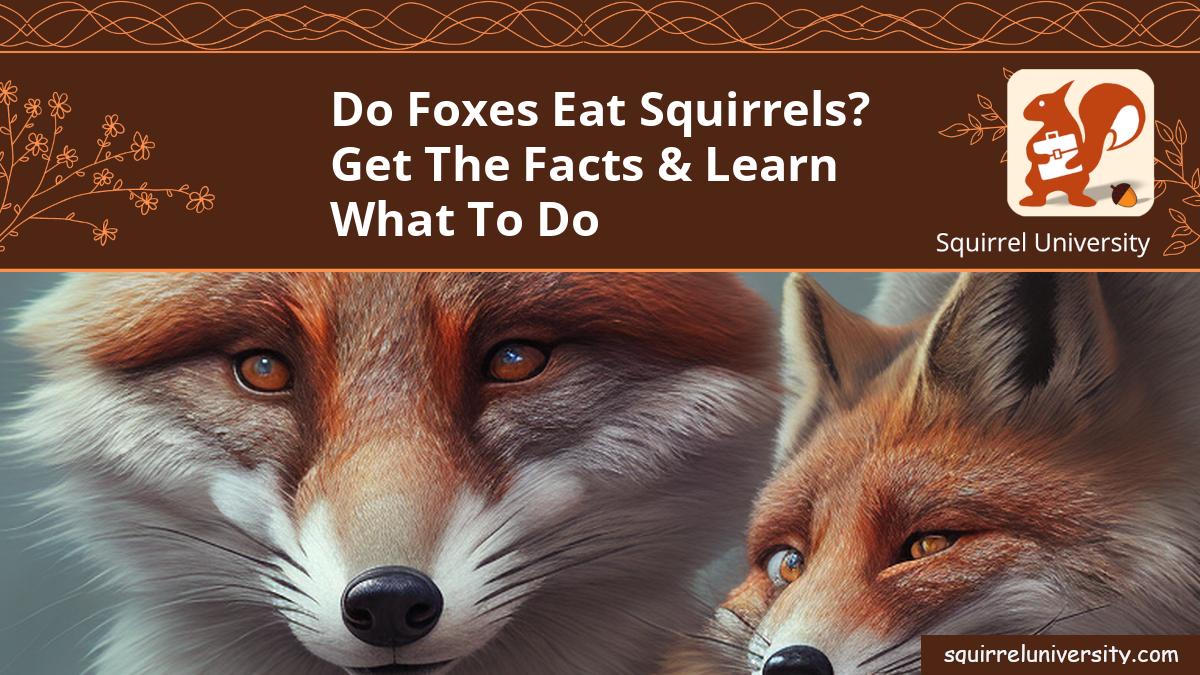As a nature lover who has spent several years studying, interacting and observing squirrels in different parts of the world, I’ve often wondered: do foxes eat squirrels? For many people, this is an important question to ask—both out of concern for our small furry friends and a desire to understand the behavior of foxes in the wild.
Yes, foxes do eat squirrels. Foxes are omnivores, meaning they eat both plant and animal matter. In addition to squirrels, their diet can consist of small mammals such as rabbits, mice, chipmunks, voles, reptiles and amphibians, as well as birds and their eggs, insects, fruit and berries. Foxes often feed on carrion unless other food sources are available.
Do Foxes Eat Squirrels?
When it comes to their diets, foxes are omnivores, which means they eat both plant and animal matter. That being said, yes, foxes do eat squirrels – as well as a variety of other small mammals such as rabbits, mice, voles, reptiles or amphibians and even some birds and their eggs.
Foxes generally prefer to hunt alone and use their sense of smell seeking out their prey from a distance in order to stalk them efficiently. But when food is scarce or the prey animal is particularly large, such as an adult groundhog for instance, then foxes may opt for cooperative hunting in groups.
The Hunting Habits of Foxes Around Squirrels
Squirrels are their preferred prey and they can consume more than one per day depending on the availability and size of the animals. When hunting squirrels, foxes tend to look for the smallest adults because those will be easier to catch. Young and newborn squirrels are also easy targets since they aren’t very agile yet.
The primary tactic used to catch a squirrel is ambush. Since this type of mammal spends most of its time running up trees or climbing branches, foxes usually wait until they come back down to the ground before making their move.
What Do Foxes Prefer To Eat?
- Small mammals like rabbits, mice, chipmunks, voles.
- Reptiles and amphibians
- Birds and eggs
- Insects
- Fruit and berries
Additionally, during summer months they may resort to eating insects such as caterpillars and frogs while in winter they might feed upon rodents or mice found on the ground. In general terms, though, foxes primarily rely on scavenging carrion unless other food sources are available to them.
Do Foxes Only Hunt In Packs?
Foxes don’t necessarily need to hunt in packs all the time. They can successfully take down smaller game such as rabbits or baby groundhogs on their own, even though they may prefer communal hunting for larger prey like deer or wild boar.
A decrease in food sources due to environment changes or development could lead to wildlife having to cooperate in order to survive. Without sufficient resources, animals may need to join forces in order to feed themselves and their young.
Environmental Factors Impacting Fox Eating Habits
Fox eating habits are greatly influenced by environmental factors, such as available food sources, territory boundaries and human interaction. Certain terrain can help foxes more easily find prey, while abundant vegetation can provide cover for ambushing certain types of animals. Additionally, urbanized habitats may lead to the availability of some unnatural food sources like discarded garbage and pet food. In general, foxes prefer to hunt smaller animals like rodents, birds, and ground squirrels.
Weather Conditions and Availability of Prey
Weather conditions have a significant influence on coyote and fox eating habits. Heavy snowfall, for example, can limit the availability of prey, like squirrels, which can lead to foxes scavenging for food in populated areas. Additionally, dry seasons diminish water sources and make it more difficult for predators to locate their prey. Thus, if there is a drought or heatwave during particular months, it is likely that foxes may hunt squirrels out of necessity.
Urbanization and Human-Related Threats
Urbanization and human-related threats are major factors impacting the environment and wild animal food sources. Urban fox populations have increased not only due to human activities like discarding of food, but also other environmental factors such as limited natural prey items. Human-related threats, such as habitat loss and persecution, can further limit wild fox’s access to food resources.
However, coyotes and foxes may exhibit “brazenness” due to accessible food sources or frequent contact with people. To protect newborn livestock, confine pregnant animals and their young during birthing season and build a fence at least 5-1/2 feet high using welded wire fencing. Coyotes are scavengers and therefore their presence near a dead animal does not necessarily mean they had killed it.
Other Animals That Prey on Squirrels
Other animals that prey on squirrels include hawks, feral cats, raccoons, weasels, snakes and opossums. Hawks are birds of prey that hunt squirrels from the air. Feral cats are domesticated cats that have escaped or been released into the wild and often hunt small rodents like squirrels.
Raccoons employ their dexterous paws when hunting for food, like squirrels. Weasels are usually brown or black furred mammals and prey on small critters such as squirrels. Snakes use venom to paralyze their victims and then use their sharp teeth and strong jaws to consume them.
Natural Predators Like Hawks and Martens
Foxes are one of the main predators of squirrels, alongside hawks and martens. They usually prey on young or sick squirrels, but can also hunt healthy adults. Coyotes and bobcats may also feed on squirrels, but in smaller numbers than foxes. To protect your squirrels, consider keeping them in an enclosed space and removing any sources of food that attract these predators.
Invasive Species like Cats and Rats
A number of non-native, invasive species can also prey on squirrels. Uncontrolled, feral cats are likely the most common mammal predators of small mammals. Additionally, rats are capable of killing and eating smaller members of their family, such as juveniles or even adults if they’re weak or injured. They will even consume baby and adult squirrels if they come across them while they’re scavenging.
Humans may unwittingly contribute to predation on squirrels if they feed the animals either intentionally or unintentionally. This could attract more predators to the area, increasing their chances of encountering vulnerable prey.
Is It Safe to Let My Pets Outside if There Are Foxes Roaming?
Although foxes typically prefer rodents for food, there have been instances when very small dogs were attacked by foxes out in nature. While it is unlikely that a fox would attack an larger domesticated pet, it is always best to supervise your pet’s activities outdoors. Additionally, harsh weather conditions or the possibility of kidnapping should be taken into consideration when deciding to leave pets outdoors unsupervised.
As long as your pet is vaccinated and healthy, you need not worry about their safety from foxes. Foxes are usually timid around humans and have evolved with other methods for obtaining food without attacking pets—including hunting rabbits and other small rodents.
Getting Rid of Foxes in Your Yard
Non-Lethal Strategies
To keep foxes away from your property, make sure they have no access to food or water by locking all garbage bins and compost piles, clearing brush piles, and covering any pools. Create a barrier with fencing around gardens, livestock enclosures, and chicken coops to prevent them from entering. During birthing season, it’s especially important to contain pregnant animals and their young for protection.
- Repellents: Animal repellents such as ammonia, predator urine or commercial products can be applied around property boundaries where it may be difficult to setup fencing.
- Noise Deterrents: Using motion sensors that trigger loud noises like noise guns or whistles can startle wildlife away from an area.
- Lighting: Installing bright lights near entry points could temporarily discourage wildlife from entering a certain area.
Fencing
To effectively exclude coyotes and foxes, a fence should be constructed at least 5-1/2 feet high using 4”x6” welded wire fencing. Barbed wire should also be added across the top and bottom edges of this fence for extra protection.
It may also be necessary to bury the fence 12-18 inches deep with the portion extending outward angled slightly outward (at 45 degrees). The lower section should be slanted downward or outward (at an angle) to prevent foxes from digging underneath the fence line.
FAQ
What type of food do foxes typically consume?
Foxes are strong predators and typically hunt small animals such as rabbits, marmots, hares, and other rodents. They also eat insects, birds, snakes, and carrion. Foxes use a variety of strategies to catch their prey, including stalking, sprinting, and pouncing.
What strategies do foxes use to capture squirrels?
Foxes hunt squirrels by slowly creeping towards them, then bursting into a lightning-fast sprint when they get close enough to lunge. When the chase is on, the fox relies on its agility and speed to get close enough to snatch the smaller animal. In most cases, however, the squirrel will detect the danger before the fox can reach it and quickly escape up a tree trunk.
Do foxes consume rabbits and squirrels as food?
Fox frequently hunt and consume rabbits and squirrels. These animals offer protein-rich diets that help foxes thrive in their habitats. Foxes hunt rabbits and squirrels by stalking or ambushing them, a tactic driven by the predator’s innate need for food and survival.
What animal are squirrels most wary of?
Squirrels have evolved to live in a world where they are hunted by many predators. Most of their fear is reserved for the one animal most likely to pursue and catch them: foxes. Foxes are crafty hunters and skilled at stalking, able to close the distance quickly with stop-and-start strides and lightning-fast sprints. The squirrel’s only defense is to flee up a nearby tree trunk, often too late to elude its pursuer.
Which animals are the primary prey of foxes?
Foxes are skillful predators and eat a variety of small animals. As omnivores, they enjoy feasting on fruits and vegetables as well. However, they are most known for hunting their favorite prey – squirrels.
- Squirrels
- Rabbits
- Birds
- Lizards
- Insects
How does a fox hunt or capture its food?
Foxes use a combination of strategies to catch their prey. First, they use a stop-and-start stalking technique to slowly close the distance between them and the squirrel. Then, when the time is right, they sprint at full speed towards the quarry in an attempt to overtake it before it has a chance to take cover. If successful, the fox can pounce on its prey and have it for dinner.
Conclusion
So, in conclusion, do foxes eat squirrels? Yes they do! Foxes are omnivores and their diet consists of a variety of small mammals, birds, eggs, insects, fruit and berries. However, they will often feed on carrion when other food sources aren’t available. As such, it would be wise to keep an eye on the location of your squirrels if you have foxes in the area.
Whether or not you can prevent foxes from preying on squirrels is something that depends on the individual circumstances. If possible, make sure there are plenty of alternative food sources for the foxes to feed on such as bird seed, fallen fruit and nuts so they don’t need to target your local squirrel population. This way we can all coexist peacefully.
You may also be interested in reading:

